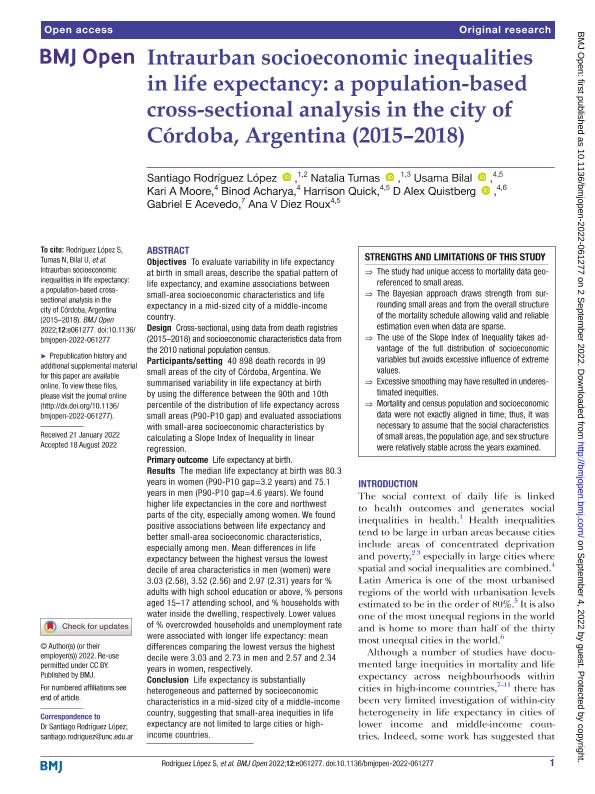Artículo
Intraurban socioeconomic inequalities in life expectancy: A population-based cross-sectional analysis in the city of Córdoba, Argentina (2015-2018)
Rodríguez López, Santiago ; Tumas, Natalia
; Tumas, Natalia ; Bilal, Usama; Moore, Kari A.; Achayra, Binod; Quick, Harrison; Quistberg, Alex; Acevedo, Gabriel Esteban; Diez Roux, Ana Victoria
; Bilal, Usama; Moore, Kari A.; Achayra, Binod; Quick, Harrison; Quistberg, Alex; Acevedo, Gabriel Esteban; Diez Roux, Ana Victoria
 ; Tumas, Natalia
; Tumas, Natalia ; Bilal, Usama; Moore, Kari A.; Achayra, Binod; Quick, Harrison; Quistberg, Alex; Acevedo, Gabriel Esteban; Diez Roux, Ana Victoria
; Bilal, Usama; Moore, Kari A.; Achayra, Binod; Quick, Harrison; Quistberg, Alex; Acevedo, Gabriel Esteban; Diez Roux, Ana Victoria
Fecha de publicación:
08/2022
Editorial:
BMJ Publishing Group
Revista:
BMJ Open
e-ISSN:
2044-6055
Idioma:
Inglés
Tipo de recurso:
Artículo publicado
Clasificación temática:
Resumen
Objectives To evaluate variability in life expectancy at birth in small areas, describe the spatial pattern of life expectancy, and examine associations between small-area socioeconomic characteristics and life expectancy in a mid-sized city of a middle-income country. Design Cross-sectional, using data from death registries (2015-2018) and socioeconomic characteristics data from the 2010 national population census. Participants/setting 40 898 death records in 99 small areas of the city of Córdoba, Argentina. We summarised variability in life expectancy at birth by using the difference between the 90th and 10th percentile of the distribution of life expectancy across small areas (P90-P10 gap) and evaluated associations with small-area socioeconomic characteristics by calculating a Slope Index of Inequality in linear regression. Primary outcome Life expectancy at birth. Results The median life expectancy at birth was 80.3 years in women (P90-P10 gap=3.2 years) and 75.1 years in men (P90-P10 gap=4.6 years). We found higher life expectancies in the core and northwest parts of the city, especially among women. We found positive associations between life expectancy and better small-area socioeconomic characteristics, especially among men. Mean differences in life expectancy between the highest versus the lowest decile of area characteristics in men (women) were 3.03 (2.58), 3.52 (2.56) and 2.97 (2.31) years for % adults with high school education or above, % persons aged 15-17 attending school, and % households with water inside the dwelling, respectively. Lower values of % overcrowded households and unemployment rate were associated with longer life expectancy: mean differences comparing the lowest versus the highest decile were 3.03 and 2.73 in men and 2.57 and 2.34 years in women, respectively. Conclusion Life expectancy is substantially heterogeneous and patterned by socioeconomic characteristics in a mid-sized city of a middle-income country, suggesting that small-area inequities in life expectancy are not limited to large cities or high-income countries.
Archivos asociados
Licencia
Identificadores
Colecciones
Articulos(CIECS)
Articulos de CENTRO DE INVESTIGACIONES Y ESTUDIO SOBRE CULTURA Y SOCIEDAD
Articulos de CENTRO DE INVESTIGACIONES Y ESTUDIO SOBRE CULTURA Y SOCIEDAD
Citación
Rodríguez López, Santiago; Tumas, Natalia; Bilal, Usama; Moore, Kari A.; Achayra, Binod; et al.; Intraurban socioeconomic inequalities in life expectancy: A population-based cross-sectional analysis in the city of Córdoba, Argentina (2015-2018); BMJ Publishing Group; BMJ Open; 12; 9; 8-2022; 1-8
Compartir
Altmétricas



